Navigating Angry Conversations
Tutor Notes
Handling angry patients and relatives is one of the greatest challenges healthcare practitioners face. This immersive training is designed to build effective communication skills that will help, not only with emotionally charged patient interactions, but with personal relationships too.
About this resource
Key learner outcome and goals
Learning Outcome
Learn how to navigate difficult conversations with an angry patient or family member
Learning Goals
- Understanding how different responses can diffuse or exacerbate anger
- Identifying anger signals
- Remaining calm in hostile situations
- Responding with empathy to move the situation forward
- Applying these techniques to different situations
A word about terminology
As a medium, Virtual Reality is not best suited to didactic teaching methods.
Our intention is that all Bodyswaps modules follow a student-centred constructivist pedagogy. This means creating rich experiences in which learners can explore key concepts and ideas and reach their own conclusions.
This is why our documents speak in terms of learning goals and outcomes, rather than measurable ‘learning objectives’ (a la Bloom’s Taxonomy) per se.
Module structure
In addition to content-based topics, the entire learner journey also incorporates ancillary activities - such as onboarding, self-reflection and the exit survey.
Ancillary activities take 3-4 minutes to complete and follow a standard format.
It is estimated that each topic will take the learner approximately 5 minutes to complete, although completion times vary depending on whether the learner chooses to repeat topics to explore different options (encouraged) or to fine-tune their freeform responses.
Learner Journey
.svg)
.svg)
- Freeform
- Gauge diagnostic
- Coaching
.svg)
- Observation
- Calming technique
.svg)
.svg)
.svg)
.svg)
.svg)
Characters
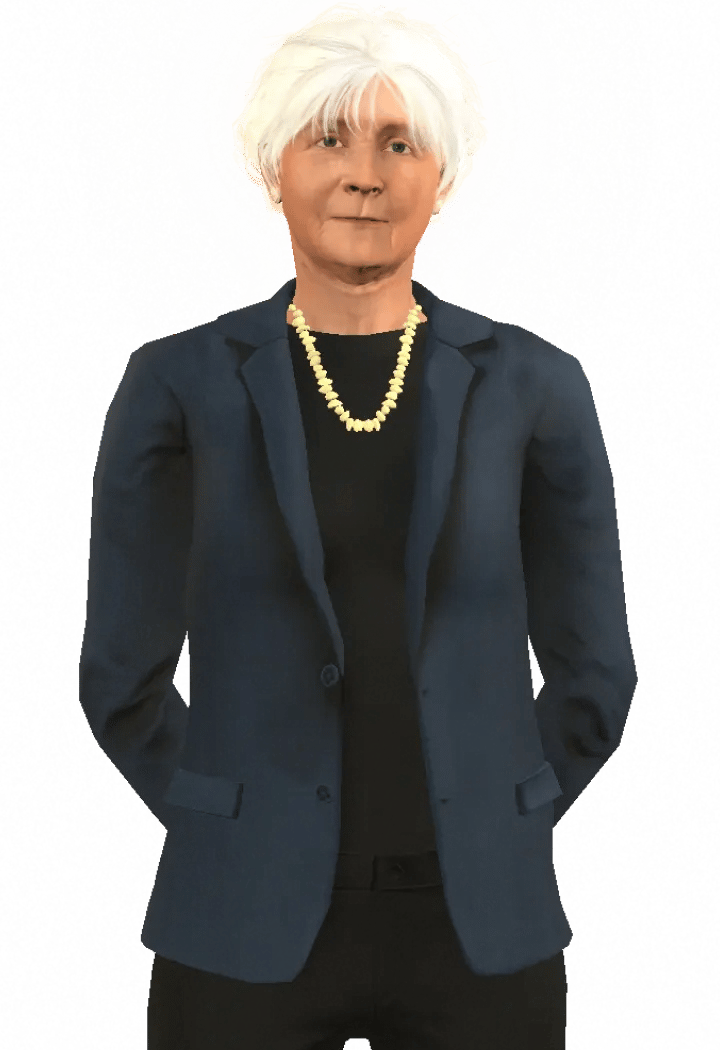

Ambika Kaling
Junior Doctor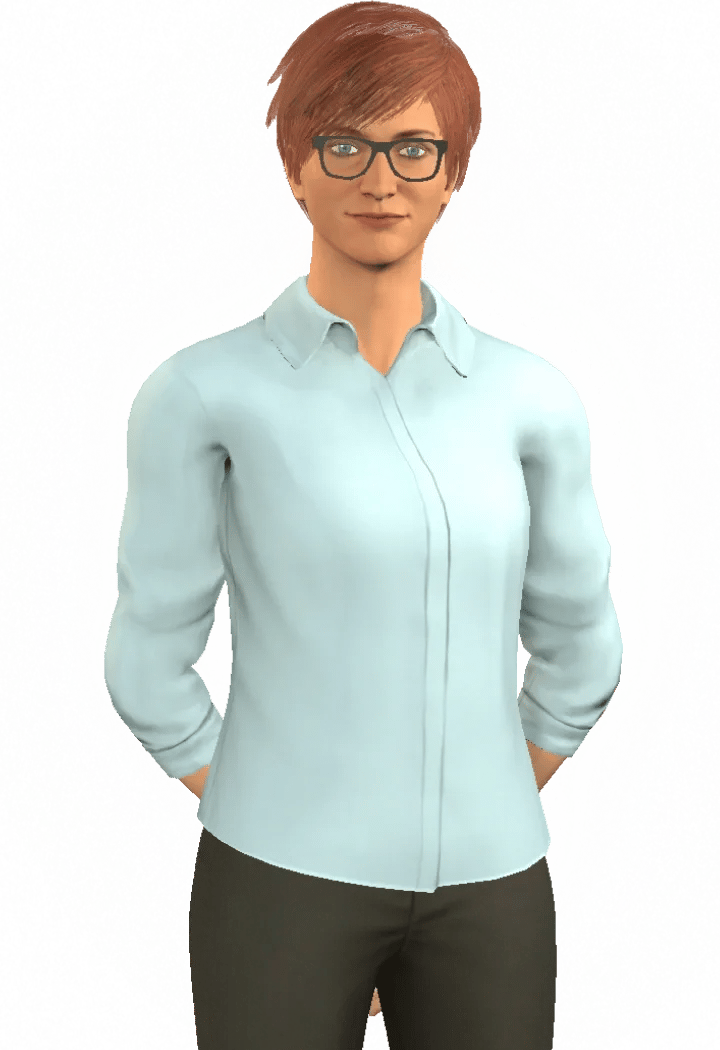
Alice Evans
Patient
Joe Evans
Husband
Major William Sanderson (Retired)
PatientLearning Environments
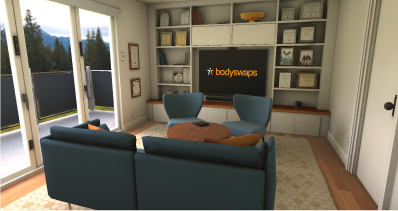
Tutor Room - Bodyswaps HQ
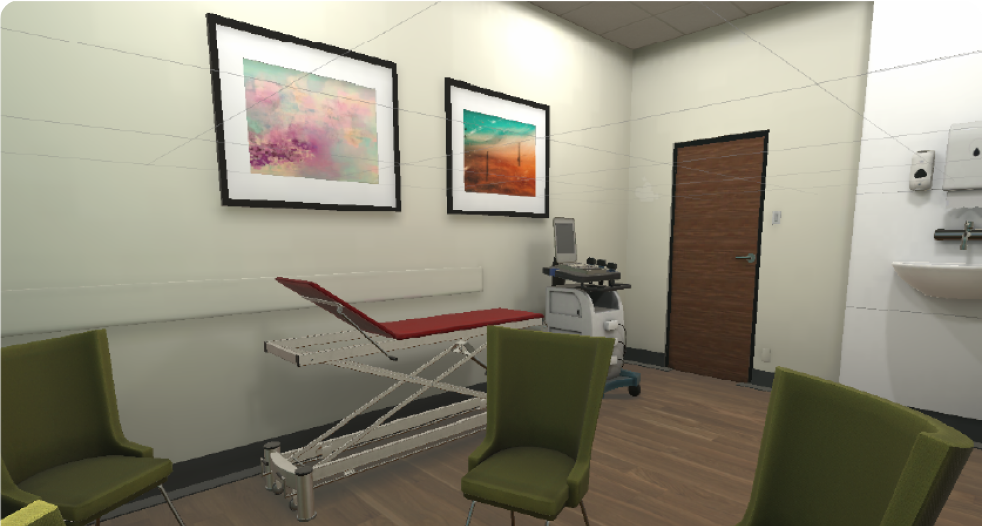
Consulting Room - Breast Clinic
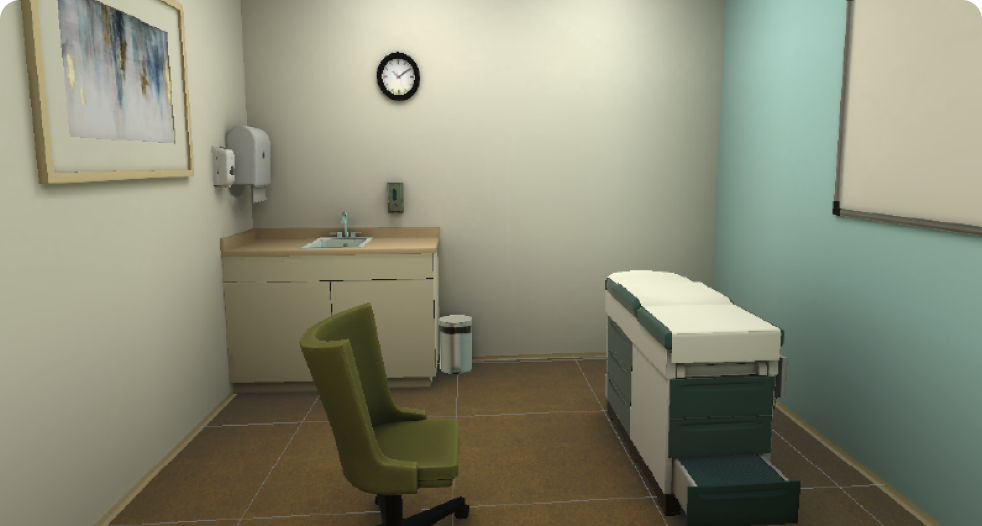
Examination Room - Urology Clinic
Purpose
Familiarise learners with the controls and navigation
Location
Characters
None
Duration
The first time learners use Bodyswaps, an onboarding sequence familiarises them with the features of the app, takes them through an avatar selection and embodiment activity and prepares them for the experience to come.
On subsequent visits to the app, the onboarding stage is bypassed, unless the learner chooses to repeat it.
This mini-onboarding takes approximately 1 minute to complete, during which, the learner will:
- Select their avatar
- Discover their virtual journal
- Learn how to navigate and use the tools and settings
Purpose
Introduce ‘Navigating Angry Conversations’ module and reflect on confidence before simulation
Location
Characters
Journal
Duration
As the onboarding session comes to a close, Professor Fallowfield appears on the screen and introduces herself as the learner’s virtual mentor.
The learner is then asked to complete a short likert-style self-reflection activity to indicate how confident they feel about the key learning points:
- Recognise how different responses can diffuse or exacerbate anger
- Identify anger signals
- Remain calm in hostile situations
- Respond appropriately and with empathy to move the situation forward
- Apply these techniques to different situations
These self-reflection questions will be repeated at the end of the simulation to assess how the learner’s confidence levels have changed.
Purpose
Encourage learners to reflect on personal experiences of angry patients and / or relatives.
Location
Tutor room
Characters
Professor Fallowfield
Journal
N/A
Duration
Professor Fallowfield opens the activity by telling the learner that healthcare professionals often report that handling angry patients is one of the most challenging aspects of their job. And, while these situations are relatively rare, they can have a significant impact.
She asks the learner to think back to the last time they had an encounter with an angry patient, patient’s family member or member of the public and describe the situation in their own words. The learner can listen to their avatar retelling this story, if they wish.
Purpose
Discover whether your natural response is likely to diffuse or exacerbate anger.
Location
Characters
Professor Fallowfield
Journal
Duration
Professor Fallowfield explains that a doctor’s response to highly emotional patients can affect how the patient discloses symptoms, recalls given information, agrees on treatment options, adheres to treatment plans, etc.
Since we all respond to anger in different ways, the first step towards being able to handle angry patients more effectively is to understand our natural inclinations.
In this activity, learners engage in a discussion with Professor Fallowfield about a time when she had to handle a conversation with an angry patient. As Lesley’s story unfolds, learners are invited to comment on what they would have done in this situation.
As her story comes to an end, Professor Fallowfield provides tailored feedback about how the learner’s responses might be interpreted by patients and the effect that this might have on the doctor-patient relationship. She then recommends an appropriate behavioural technique that the learner can use to stay calm, think more clearly and defuse - not exacerbate - similar situations in the future.
Purpose
Learn techniques for staying calm in hostile situations.
Location
Tutor room
Characters
Professor Fallowfield, Ambika Kaling
Journal
N/A
Duration
Learners meet Junior Doctor, Ambika Kaling, a former student of Professor Fallowfield. Ambika has already experienced her fair share of angry encounters and has learned various techniques for staying calm in hostile situations.
Ambika coaches the learner in the personal calming technique that best suits the learner’s natural response, as identified in the previous activity.
There are three techniques that Ambika can teach:
- Depersonalisation - recommended for learners who try to control or dominate the situation
- Grounding - recommended for learners who react in the moment with acute stress response
- Box breathing - recommended to help learners who already react with empathy and emotional intelligence to care for their own wellbeing as well.
Purpose
Raise awareness of behaviours that indicate anger.
Location
Tutor room (intro only), Consulting room in a breast clinic
Characters
Professor Fallowfield - Virtual mentor
Lucy - Breast cancer patient
Joe - Patient’s husband
Ambika - Junior doctor
Journal
Duration
In this activity, the learner witnesses a challenging consultation between Ambika and her patient, Lucy.
Lucy has already had a series of diagnostic tests and Ambika is trying to explain the next steps. But Lucy’s husband, Joe, is becoming increasingly angry because (among other things) they have been at the clinic for 3 hours and still don’t have a definitive answer…”
While the learner watches, they click to identify the anger signals that Joe is exhibiting. Visual feedback indicates if the learner has correctly identified a behaviour or missed one that has just passed.
At the end of the animation, summary feedback is provided, with a panel of buttons indicating which events were identified. Clicking on a button rewinds the animation to the corresponding instance and provides additional text information about its significance.
Tailored feedback is provided by Professor Fallowfield at the end.
Purpose
Practise techniques for staying calm in hostile situations.
Location
Consultation room - Breast clinic
Characters
Lucy - Breast cancer patient
Joe - Patient’s husband
Ambika - Junior doctor
Journal
Duration
Now the learner ‘bodyswaps’ into Ambika’s avatar to witness the consultation through Ambika’s eyes and ears.
The observation scene is repeated and the learner is encouraged to practise their personal calming technique with the aid of a heads-up display (HUD). Depending on their recommended technique, the following will happen:
- Depersonalisation - Each time a cue word or phrase is uttered, the word is added to an image of a bucket, floating between them and their patient.
- Grounding - A HUD of the foot outline appears and along with instructions to ‘Plant your feet’, ‘Feel the ground supporting you’ and then an animated dot traces the outline of one foot.
- Breathing - An animated box is displayed in the HUD with an instruction to ‘Breathe in’ for a count of 4, ‘Hold’ for a count of 4, ‘Exhale’ for a count of 4, ‘Hold’ for a count of 4. This repeats 3 times, then disappears.
The learner can skip the the end of this activity when they have spent enough time practising or they can try one of the other techniques, then move on.
Purpose
Learn how to respond appropriately and with empathy and move the conversation forwards
Location
Intro - Tutor room
Activity - Consultation room, breast clinic
Characters
Professor Fallowfield
Ambika
Lucy
Joe
Journal
Duration
Now that Joe is starting to calm down, it’s time for the learner to respond with empathy; setting aside their own views and opinions to better see and understand the situation from the other person’s perspective.
The right response here will help Joe and Lucy feel listened to and understood, providing the reassurance they need to respond with trust instead of anger.
This activity scaffolds a simple formula for responding with empathy to move the situation forwards:
- Offer an apology
- See the situation through their eyes
- Withhold judgement
- Name and validate the emotion
- Be collaborative
At each stage in the conversation, the learner chooses what to say from three given options - each of which elicits a different response from Lucy or Joe. A pop-up also provides additional information about the implications of what they said.
Purpose
Practise responding to angry people with empathy.
Location
Intro - Tutor room
Activity - Examination room, urology clinic
Characters
Intro - Lesley and Ambika
Activity - Major William Sanderson
Journal
N/A
Duration
7:00
Now it’s time for the learner to practise their skills in a new scenario.
This time, the learner meets an older gentleman who has recently developed urinary incontinence. Major Sanderson’s toxic combination of self-importance, entitlement and embarrassment manifests as an irrational anger towards the learner, who must use their skills to calm him down and win his patience and cooperation.
To help the learner in their task, the ‘responding with empathy strategy’ is displayed in the environment as a reminder. Hints specifically relating to the patient can also be seen by consulting the virtual journal at any stage in the interaction.
As the learner talks, their response is recorded and analytics measure key verbal and non-verbal aspects of their performance. This is followed with personalised feedback identifying areas for improvement.
Purpose
Debrief the learner upon completion of the training and self-reflection.
Location
Tutor room
Characters
Professor Lesley Fallowfield
Journal
N/A
Duration
The primary function of the debrief activity is to encourage the learner to reflect and self-report on their confidence levels following completion of the training.
Here, the learner is asked the to complete the same likert-style self-reflection activity they were given in the introduction. Questions relate to how confident they now feel about the key learning points:
- Recognising how different responses can diffuse or exacerbate anger
- Identifying anger signals
- Remaining calm in hostile situations
- Responding appropriately and with empathy to move the situation forward
- Applying these techniques to different situations
Purpose
Assess the effectiveness of the training itself.
Location
Characters
Journal
Duration
1:00
Before the learner leaves the module, they are asked to complete a short survey about their experience.
This survey is not compulsory, but the data helps us to assess the effectiveness of our product and identify any areas that need improvement. Clients also find it beneficial when assessing ROI.
Questions relate to:
- Advocacy
- Awareness
- Comprehension
